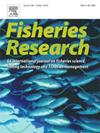Estimating the trapping area and density of common whelk (Buccinum undatum) using experimental fishing
IF 2.2
2区 农林科学
Q2 FISHERIES
引用次数: 0
Abstract
For many species targeted by static gear fisheries, the relationship between catch per unit effort (CPUE) and density on the seabed is poorly understood. One aspect that is crucial in understanding this relationship is the area from which catches are drawn, known as the trapping area, yet this remains largely unquantified. In this paper we investigate the size of the trapping area for the commercially important common whelk (Buccinum undatum) by studying variations in CPUE in relation to the distance between pots. With declining spacing, the sphere of attraction will increasingly overlap, leading to reductions in catches and allowing the density of catchable animals to be estimated. Experimental fishing took place with pot distances ranging from 4 to 50 m, with catches recorded for over 500 pots over a week-long period. In addition to pot spacing, deployment location and haul date were significant factors influencing CPUE. For the study site, and based on environmental conditions at the time, the trapping area was estimated to be 120 m2, indicating whelk pots spaced at least 12–13 m apart are likely to fish independently of each other. This resulted in a density estimate of 0.9 individuals m−2, with spatial variation between 0.4 and 1.2 individuals m−2. Results suggest pot spacings in the local fishery are sufficient to avoid interactions, and there is potential to predict densities from commercial CPUE, although further work is needed to understand variability in the size of the trapping area in relation to environmental and biotic factors.
采用实验捕鱼法估计普通海螺的捕集面积及密度
对于静态渔具渔业所针对的许多物种,单位努力捕获量(CPUE)与海底密度之间的关系了解甚少。理解这种关系的一个关键方面是捕获物的区域,即捕获区,但这在很大程度上仍未量化。在本文中,我们通过研究CPUE的变化与锅间距离的关系来研究商业上重要的普通海螺(Buccinum undatum)的捕获区域的大小。随着间距的减小,吸引范围将越来越多地重叠,导致捕获量减少,并使可捕获动物的密度得以估计。实验捕鱼的锅距为4至50 米,在为期一周的时间内记录了500多个锅的渔获量。除储层间距外,部署位置和运输日期也是影响CPUE的重要因素。对于研究地点,根据当时的环境条件,捕获面积估计为120 m2,这表明间距至少为12-13 m的螺罐可能彼此独立捕鱼。这导致密度估计为0.9个体m−2,空间变化在0.4和1.2个体m−2之间。结果表明,当地渔业的锅间距足以避免相互作用,并且有可能预测商业CPUE的密度,尽管需要进一步的工作来了解与环境和生物因素相关的捕获区域大小的变化。
本文章由计算机程序翻译,如有差异,请以英文原文为准。
求助全文
约1分钟内获得全文
求助全文
来源期刊

Fisheries Research
农林科学-渔业
CiteScore
4.50
自引率
16.70%
发文量
294
审稿时长
15 weeks
期刊介绍:
This journal provides an international forum for the publication of papers in the areas of fisheries science, fishing technology, fisheries management and relevant socio-economics. The scope covers fisheries in salt, brackish and freshwater systems, and all aspects of associated ecology, environmental aspects of fisheries, and economics. Both theoretical and practical papers are acceptable, including laboratory and field experimental studies relevant to fisheries. Papers on the conservation of exploitable living resources are welcome. Review and Viewpoint articles are also published. As the specified areas inevitably impinge on and interrelate with each other, the approach of the journal is multidisciplinary, and authors are encouraged to emphasise the relevance of their own work to that of other disciplines. The journal is intended for fisheries scientists, biological oceanographers, gear technologists, economists, managers, administrators, policy makers and legislators.
 求助内容:
求助内容: 应助结果提醒方式:
应助结果提醒方式:


